Fishing cat
The fishing cat (Prionailurus viverrinus) is a medium-sized wild cat of South and Southeast Asia. Since 2016, it is listed as Vulnerable on the IUCN Red List. Fishing cat populations are threatened by destruction of wetlands and have declined severely over the last decade.[1] The fishing cat lives foremost in the vicinity of wetlands, along rivers, streams, oxbow lakes, in swamps, and mangroves.[2]
| Fishing cat | |
|---|---|
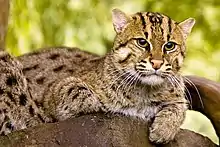 | |
Conservation status | |
| Scientific classification | |
| Kingdom: | Animalia |
| Phylum: | Chordata |
| Class: | Mammalia |
| Order: | Carnivora |
| Suborder: | Feliformia |
| Family: | Felidae |
| Subfamily: | Felinae |
| Genus: | Prionailurus |
| Species: | P. viverrinus |
| Binomial name | |
| Prionailurus viverrinus (Bennett, 1833) | |
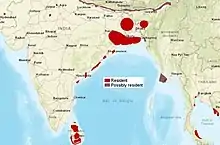 | |
| Distribution of the fishing cat as of 2016[1] | |
The fishing cat is the state animal of West Bengal.[3]
Taxonomy
Felis viverrinus was proposed by Edward Turner Bennett in 1833 who described a fishing cat skin from India.[4] Prionailurus was proposed by Nikolai Severtzov in 1858 as generic name for spotted wild cats native to Asia.[5] Felis viverrinus rhizophoreus was proposed by Henri Jacob Victor Sody in 1936 who described a specimen from the north coast of West Java that had a slightly shorter skull than fishing cat specimens from Thailand.[6] There is evidence that the nominate taxon and the Javan fishing cat are distinguishable by skull morphometrics.[7]
Phylogeny
Phylogenetic analysis of the nuclear DNA in tissue samples from all Felidae species revealed that the evolutionary radiation of the Felidae began in Asia in the Miocene around 14.45 to 8.38 million years ago.[8][9] Analysis of mitochondrial DNA of all Felidae species indicates a radiation at around 16.76 to 6.46 million years ago.[10]
The Prionailurus species are estimated to have had a common ancestor between 8.16 to 4.53 million years ago,[8] and 8.76 to 0.73 million years ago.[10] Both models agree in the rusty-spotted cat (P. rubiginosus) having been the first cat of the Prionailurus lineage that genetically diverged, followed by the flat-headed cat (P. planiceps) and then the fishing cat.[8][10] It is estimated to have diverged together with the leopard cat (P. bengalensis) between 4.31 to 1.74 million years ago[8] and 4.25 to 0.02 million years ago.[10] The following cladogram shows the phylogenetic relationships of the fishing cat as derived through analysis of nuclear DNA:[8][9]
|
Characteristics
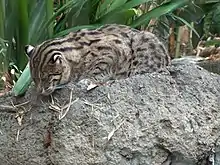
The fishing cat has a deep yellowish-grey fur with black lines and spots. Two stripes are on the cheeks, and two above the eyes running to the neck with broken lines on the forehead. It has two rows of spots around the throat. The spots on the shoulder are longitudinal, and those on the sides, limbs and tail are roundish.[4] The background colour of its fur varies between individuals from yellowish tawny to ashy grey, and the size of the stripes from narrow to broad. The fur on the belly is lighter than on the back and sides. The short and rounded ears are set low on the head, and the back of the ears bear a white spot. The tail is short, less than half the length of head and body, and with a few black rings at the end.[11] As an aquatic adaptation, the fur is layered. A short, dense layer provides a water barrier and thermal insulation, while another layer of protruding long guard hairs provides its pattern and glossy sheen.[12]
The fishing cat is the largest cat of the Prionailurus.[11] It is about twice the size of a domestic cat and stocky and muscular with medium to short legs. Its head-to-body length ranges from 57 to 78 cm (22 to 31 in), with a tail of 20 to 30 cm (7.9 to 11.8 in). Female fishing cats range in weight from 5 to 9 kg (11 to 20 lb), and males from 8 to 17 kg (18 to 37 lb), evidencing quite pronounced sexual dimorphism in size for a cat of this size.[13] Its skull is elongated, with a basal length of 123–153 mm (4.8–6.0 in) and a post-orbital width of 27–31 mm (1.1–1.2 in).[11]
Its paws are less completely webbed than those of the leopard cat, and the claws are incompletely sheathed so that they protrude slightly when retracted.[11] Webbed feet have often been noted as a characteristic of the fishing cat, but the webbing beneath the toes is not much more developed than that of a bobcat.[14]
Distribution and habitat
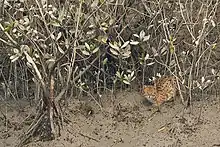
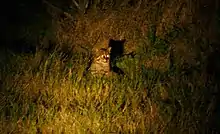
The fishing cat is broadly but discontinuously distributed in South and Southeast Asia.[1] It is strongly associated with wetlands, inhabiting swamps and marshy areas around oxbow lakes, reed beds, tidal creeks and mangrove forests; it seems less abundant around smaller, fast-moving watercourses. Most records are from lowland areas.[2]
In Pakistan's Sindh Province, the fishing cat was recorded in the Chotiari Dam area in 2012.[15]
In the Nepal Terai, it has been recorded in Shuklaphanta, Bardia, Chitwan and Parsa National Parks and in Koshi Tappu Wildlife Reserve.[16][17][18][19][20]
In India, its presence has been documented in:
- Ranthambore National Park,[21] in Pilibhit,[16] Dudhwa and Valmiki Tiger Reserves,[1] in Sur Sarovar Bird Sanctuary,[22]
- outside protected areas in West Bengal,[23] in Lothian Island Wildlife Sanctuary in the Sundarbans,[24]
- in Odisha's Bhitarkanika Wildlife Sanctuary and coastal districts outside protected areas,[25]
- in Andhra Pradesh's Coringa Wildlife Sanctuary, Krishna Wildlife Sanctuary and adjoining reserve forests.[26][27][28][29]
Reports in Bangladeshi newspapers indicate that fishing cats live in all divisions of Bangladesh but are severely threatened; villagers killed at least 30 fishing cats between January 2010 and March 2013.[30] In Sri Lanka, it has been recorded in multiple localities ranging from coastal to hilly regions.[1]
In Myanmar, it was recorded in the Ayeyarwady Delta in 2016 and 2018.[31]
In Thailand, its presence has been documented in Khao Sam Roi Yot National Park and Thale Noi Non-Hunting Area along the coast, and in Kaeng Krachan National Park.[32][33] Between 2007 and 2016, it was also recorded near wetlands outside protected areas in Phitsanulok Province, Bang Khun Thian District, Samut Sakhon Province, Phetchaburi and Songkhla Provinces, and near a mangrove site in Pattani.[34]
In Cambodia, a single fishing cat was photographed by a camera trap in Kulen Promtep Wildlife Sanctuary in March 2003.[35] In 2008, a fishing cat kitten was found in Botum-Sakor National Park.[36] In 2015, it was also recorded in Peam Krasop Wildlife Sanctuary.[37]
The island of Java constitutes the southern limit of the fishing cat's range, but by the 1990s fishing cats were scarce and apparently restricted to tidal forests with sandy or muddy shores, older mangrove stands, and abandoned mangrove plantation areas with fishponds.[38] There are no confirmed records from Peninsular Malaysia, Vietnam and Laos.[39]
Behaviour and ecology
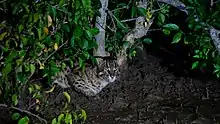
The fishing cat is thought to be primarily nocturnal, and is very much at home near water. It can swim long distances, even under water. Adult males and females without dependent young are solitary. Females have been reported to range over areas of 4 to 6 km2 (1.5 to 2.3 sq mi), while males range over 16 to 22 km2 (6.2 to 8.5 sq mi). Adults have been observed to make a "chuckling" sound.[13]
The fishing cat's main prey is fish; scat collected in India's Keoladeo National Park revealed that fish comprises about three-quarters of its diet, with the remainder consisting of birds, insects, small rodents; molluscs, reptiles including snakes, amphibians and carrion of domestic cattle supplement its diet.[40] Fishing cats have been observed while hunting along the edges of watercourses, grabbing prey from the water, and sometimes diving into the water to catch prey further from the banks.[41]
It marks its home range using cheek-rubbing, head rubbing, chin rubbing, neck rubbing and urine-spraying to leave scent marks. It also sharpens its claws and displays flehmen.[42]
Reproduction and development
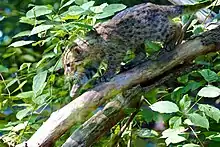
Wild fishing cats most likely mate during January and February; most kittens in the wild were observed in March and April.[13] In captivity, the gestation period lasts 63–70 days; females give birth to two or three kittens.[42] They weigh around 170 g (6.0 oz) at birth, and are able to actively move around by the age of one month. They begin to play in water and to take solid food when about two months old, but are not fully weaned until six months old. They reach full adult size when about eight and a half months old, acquire their adult canine teeth by 11 months, and are sexually mature when approximately 15 months old. They live up to 10 years in captivity.[13]
Threats
The fishing cat is threatened by destruction of wetlands, which are increasingly being polluted and converted for agricultural use and human settlements. The conversion of mangrove forests to commercial aquaculture ponds is a major threat in Andhra Pradesh, where the targeted killing of fishing cats is also prevalent where there is human/animal conflict. Over-exploitation of local fish stocks and retaliatory killing are also significant threats.[1] In West Bengal's Howrah district, 27 dead fishing cats were recorded between April 2010 and May 2011.[23] In Bangladesh, at least 30 fishing cats were killed by local people in three years between January 2010 and March 2013.[30] Furthermore, in a study in Thailand, 84% of all fishing cats that were tracked via radio collars were killed – either due to poaching or unknown causes.[1]
The fishing cat is possibly extinct in coastal Kerala, India.[43]
Conservation
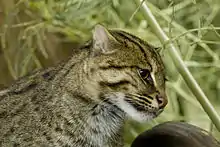
Prionailurus viverrinus is included on CITES Appendix II, and protected by national legislation over most of its range. Hunting is prohibited in Bangladesh, Cambodia, China, India, Indonesia, Myanmar, Nepal, Pakistan, Sri Lanka, Thailand. Hunting regulations apply in Lao PDR. In Bhutan and Vietnam, the species is not protected outside protected areas.[2] Its survival depends on protection of wetlands, prevention of indiscriminate trapping, snaring and poisoning.[1]
In areas where habitat degradation is a major concern, such as coastal Andhra Pradesh, NGOs are working to slow habitat conversion in collaboration with local villagers. Part of this work involves creating alternative livelihood programs that allow villagers to earn money without damaging natural habitats.[44][45]
In captivity

Fishing cat captive breeding programmes have been established by the European Association of Zoos and Aquaria and the American Association of Zoos and Aquariums. All the fishing cats kept in zoos around the world are listed in the International Studbook of the World Association of Zoos and Aquariums.
Local names
In Assamese, the fishing cat is known as meseka (Assamese: মেচেকা), probably derived from mas (Assamese: মাছ) meaning "fish".
In Bengali, the fishing cat is known as "mach-baghrol" (Bengali: বাঘরোল) and "bagh-dasha".[46] "Mācha" means "fish", and "bāgha" means "tiger".[47]
In Hindi, it is known as "bunbiral" and "khupya bagh".[48]
In Telugu, it is called "bavuru pilli" meaning "wild cat".[49]
In Sinhala, the fishing cat is known as (හදුන් දිවියා), "handun diviya".[50]
In Thai, it is called "suea pla" (Thai: เสือปลา; RTGS: suea pla), literally "fish tiger".[51]
In Burmese, it is called "Kyaung-ta-nga" "ကြောင်တံငါ" "Kyaung" means "cat" and "ta-nga" means "fisherman".
References
- Mukherjee, S.; Appel, A.; Duckworth, J.W.; Sanderson, J.; Dahal, S.; Willcox, D.H.A.; Herranz Muñoz, V.; Malla, G.; Ratnayaka, A.; Kantimahanti, M.; Thudugala, A.; Thaung, R. & Rahman, H. (2016). "Prionailurus viverrinus". IUCN Red List of Threatened Species. 2016: e.T18150A50662615. doi:10.2305/IUCN.UK.2016-2.RLTS.T18150A50662615.en. Retrieved 24 January 2022.
- Nowell, K. & Jackson, P. (1996). "Fishing Cat, Prionailurus viverrinus (Bennett, 1833)". Wild Cats: status survey and conservation action plan (PDF). Gland, Switzerland: IUCN/SSC Cat Specialist Group. pp. 74−76. ISBN 978-2-8317-0045-8.
- Wildlife Institute of India. "State animals, birds, trees and flowers" (PDF). Wildlife Institute of India. Archived from the original (PDF) on 15 June 2007. Retrieved 5 March 2012.
- Bennett, E. T. (1833). "Felis viverrinus". Proceedings of the Zoological Society of London. Part I: 68–69.
- Severtzow, M. N. (1858). "Notice sur la classification multisériale des Carnivores, spécialement des Félidés, et les études de zoologie générale qui s'y rattachent". Revue et Magasin de Zoologie Pure et Appliquée. X: 385–396.
- Sody, H. J. V. (1936). "Seventeen generic, specific and subspecific names for Dutch East Indian mammals". Natuurkundig Tijdschrift voor Nederlandsch Indië. 96: 42−55.
- Jusoh, W. F. A.; Chua, M. A. H.; Bakker, P. A. J.; Kamminga, P.; Weiler, D.; Rookmaaker, K. & Low, M. E. Y. (2022). "A historical specimen of the Fishing Cat, Prionailurus viverrinus (Bennett, 1833) (Carnivora, Felidae) from Singapore in the zoological collection of the Naturalis Biodiversity Center, Leiden". Zoosystematics and Evolution. 98 (1): 43–53. doi:10.3897/zse.98.76940. S2CID 246172906.
- Johnson, W. E.; Eizirik, E.; Pecon-Slattery, J.; Murphy, W. J.; Antunes, A.; Teeling, E. & O'Brien, S. J. (2006). "The Late Miocene radiation of modern Felidae: A genetic assessment". Science. 311 (5757): 73–77. Bibcode:2006Sci...311...73J. doi:10.1126/science.1122277. PMID 16400146. S2CID 41672825.
- Werdelin, L.; Yamaguchi, N.; Johnson, W. E. & O'Brien, S. J. (2010). "Phylogeny and evolution of cats (Felidae)". In Macdonald, D. W. & Loveridge, A. J. (eds.). Biology and Conservation of Wild Felids. Oxford, UK: Oxford University Press. pp. 59–82. ISBN 978-0-19-923445-5.
- Li, G.; Davis, B. W.; Eizirik, E. & Murphy, W. J. (2016). "Phylogenomic evidence for ancient hybridization in the genomes of living cats (Felidae)". Genome Research. 26 (1): 1–11. doi:10.1101/gr.186668.114. PMC 4691742. PMID 26518481.
- Pocock, R. I. (1939). "Prionailurus viverrinus". The Fauna of British India, including Ceylon and Burma. Vol. 1. Mammalia. London: Taylor and Francis, Ltd. pp. 281–284.
- "Fishing Cat". The International Society for Endangered Cats (ISEC) Canada. 21 December 2012. Retrieved 25 May 2020.
- Sunquist, M. & Sunquist, F. (2002). "Fishing Cat Prionailurus viverrinus (Bennett, 1833)". Wild Cats of the World. Chicago: University of Chicago Press. pp. 241–245. ISBN 978-0-226-77999-7.
- Kitchener, A. C. (1998). The Natural History of the Wild Cats. Ithaca, New York: Cornell University Press.
- Islam, S.; Nawaz, R. & Moazzam, M. (2015). "A survey of Smooth-coated Otter (Lutrogale perspicillata sindica) and Fishing Cat (Prionailurus viverrinus) in Chotiari Reservoir, Sanghar, Pakistan using camera traps". International Journal of Biology and Biotechnology. 12 (4): 579–584.
- Yadav, B.P.; Appel, A.; Shrestha, B.P.; Dahal, B.R. & M. Dhakal (2020). "The Fishing Cat Prionailurus viverrinus (Bennett, 1833) (Mammalia: Carnivora: Felidae) in Shuklaphanta National Park, Nepal". Journal of Threatened Taxa. 12 (16): 17203–17212. doi:10.11609/jott.6145.12.16.17203-17212.
- Yadav, S. K.; Lamichhane, B. R.; Subedi, N.; Dhakal, M.; Thapa, R. K.; Poudyal, L. & Dahal, B. R. (2018). "Fishing Cat camera trapped in Babai Valley of Bardia National Park, Nepal". Cat News (67): 31–33.
- Mishra, R.; Basnet, K.; Amin, R. & Lamichhane, B. R. (2018). "Fishing Cat Prionailurus viverrinus Bennett, 1833 (Carnivora: Felidae) distribution and habitat characteristics in Chitwan National Park, Nepal". Journal of Threatened Taxa. 10 (11): 12451–12458. doi:10.11609/jott.3426.10.11.12451-12458.
- Poudel, S.; Lamichhane, B. R.; Bhattarai, S.; Adhikari, D.; Pokheral, C.; Bhatta, T.; Giri, S.; Lamichhane, S.; Sadaula, A.; Gurung, A.; Poudyal, L.; Regmi, U. & Subedi, N. (2019). "First photographic evidence of Fishing Cat Prionailurus viverrinus Bennett, 1833 and Clouded Leopard Neofelis nebulosa Griffith, 1821 (Carnivora: Felidae) in Parsa National Park, Nepal". Journal of Threatened Taxa. 11 (4): 13497–13501. doi:10.11609/jott.4549.11.4.13497-13501.
- Taylor, I. R.; Baral, H.S.; Pandey, P. & Kaspal, P. (2016). "The conservation status of the Fishing Cat Prionailurus viverrinus Bennett, 1833 (Carnivora: Felidae) in Koshi Tappu Wildlife Reserve, Nepal". Journal of Threatened Taxa. 8 (1): 8323–8332. doi:10.11609/jott.2034.8.1.8323-8332.
- Sadhu, A. & Reddy, G. V. (2013). "First evidence of Fishing Cat in the Ranthambhore Tiger Reserve, Rajasthan, India". Cat News (58): 36–37.
- Prerna, S.; Raj, B.; Sharma, V.; Seshamani, G. & Satayanarayan, K. (2016). "First record of Fishing Cat in Sur Sarovar Bird Sanctuary, Agra, India". Cat News (63): 19–20.
- Mukherjee, S.; Adhya, T.; Thatte, P. & Ramakrishnan, U. (2012). "Survey of the Fishing Cat Prionailurus viverrinus Bennett, 1833 (Carnivora: Felidae) and some aspects impacting its conservation in India". Journal of Threatened Taxa. 4 (14): 3355–3361. doi:10.11609/JoTT.o3199.3355-61.
- Das, S. K.; Saha, R.; Mukherjee, S.; Danda, A. A. & Borah, J. (2017). "First estimates of fishing cat abundance and density in Lothian WS, Sundarbans, India". Cat News (66): 25−27.
- Palei, H. S.; Das, U. P. & Debata, S. (2018). "The Vulnerable Fishing Cat Prionailurus viverrinus in Odisha, eastern India: status and conservation implications". Zoology and Ecology. 28 (2): 69–74. doi:10.1080/21658005.2018.1468646.
- Malla, G. & Sivakumar, K. (2014). "The Coringa Mangroves—realm of the Fishing Cat". Sanctuary Asia. XXXIV (6).
- Malla, G. (2016). "Ecology and conservation of Fishing Cat in Godavari mangroves of Andhra Pradesh" (PDF). In A. Appel; J. W. Duckworth (eds.). Proceedings of the First International Fishing Cat Conservation Symposium, 25–29 November 2015, Nepal. Bad Marienberg, Germany and Saltford, Bristol, United Kingdom: Fishing Cat Working Group. pp. 48–50. Archived from the original (PDF) on 8 October 2017. Retrieved 4 October 2016.
- Sathiyaselvam, P. & Eswar Satyanarayana, J. (2016). Status of Fishing Cat and Indian Smooth-coated Otter in Coringa Wildlife Sanctuary (PDF). Kakinada: EGREE Foundation. Archived from the original (PDF) on 2016-09-24. Retrieved 2016-09-24.
- Kantimahanti, M. (2016). "Community-based Fishing Cat conservation in the Eastern Ghats of South India" (PDF). In A. Appel; J. W. Duckworth (eds.). Proceedings of the First International Fishing Cat Conservation Symposium, 25–29 November 2015, Nepal. Bad Marienberg, Germany and Saltford, Bristol, United Kingdom: Fishing Cat Working Group. pp. 51–54. Archived from the original (PDF) on 8 October 2017. Retrieved 4 October 2016.
- Chowdhury, S. U.; Chowdhury, A. R.; Ahmed S. & Muzaffar, S. B. (2015). "Human-fishing cat conflicts and conservation needs of fishing cats in Bangladesh". Cat News (62): 4–7.
- Naing Lin & Platt, S. G. (2019). "Recent photographic records of Fishing Cat Prionailurus viverrinus (Bennett, 1833) (Carnivora: Felidae) in the Ayeyarwady Delta of Myanmar". Journal of Threatened Taxa. 11 (7): 13910–13914. doi:10.11609/jott.4795.11.7.13910-13914.
- Cutter, P. (2009). "Recent sightings of fishing cats in Thailand". Cat News (51): 12–13.
- Lynam, A. J.; Jenks, K. E.; Tantipisanuh, N.; Chutipong, W.; Ngoprasert, D. & Gale, G. A. (2012). "Terrestrial activity patterns of wild cats from camera-trapping" (PDF). Raffles Bulletin of Zoology: 407–415. Archived from the original (PDF) on 2014-02-01.
- Chutipong, W.; Kamjing, A.; Klinsawat, W.; Ngoprasert, D.; Phosri, K.; Sukumal, N.; Wongtung, P. & Tantipisanuh, N. (2019). "An update on the status of Fishing Cat Prionailurus viverrinus Bennett, 1833 (Carnivora: Felidae) in Thailand". Journal of Threatened Taxa. 11 (4): 13459–13469. doi:10.11609/jott.4557.11.4.13459-13469.
- Rainey, H. J. & Kong, K. (2010). "A fishing cat observation from northern Cambodia" (PDF). Cat News (52): 8–9. Archived from the original (PDF) on 2016-03-19. Retrieved 2011-10-23.
- Royan, A. (2009). "Confirmation of the endangered fishing cat in Botum-Sakor National Park, Cambodia" (PDF). Cat News (51): 10–11.
- Thaung R. & Herranz Muñoz, V. (2016). "Identifying priority sites and conservation actions for Fishing Cat in Cambodia" (PDF). In A. Appel & J. W. Duckworth (eds.). Proceedings of the First International Fishing Cat Conservation Symposium, 25–29 November 2015, Nepal. Bad Marienberg, Germany and Saltford, Bristol, United Kingdom: Fishing Cat Working Group. pp. 37–40. Archived from the original (PDF) on 8 October 2017. Retrieved 4 October 2016.
- Melisch, R.; Asmoro, P. B.; Lubis, I. R. & Kusumawardhani, L. (1996). "Distribution and status of the Fishing Cat (Prionailurus viverrinus rhizophoreus Sody, 1936) in West Java, Indonesia (Mammalia: Carnivora: Felidae)" (PDF). Faunistische Abhandlungen, Staatliches Museum für Tierkunde Dresden. 20 (17): 311–319. Archived from the original (PDF) on 2013-03-23. Retrieved 2011-04-24.
- Duckworth, J. W.; Stones, T.; Tizard, R.; Watson, S. & Wolstencroft, J. (2010). "Does the fishing cat inhabit Laos?". Cat News (52): 4–7.
- Haque, N. M. & Vijayan, V. (1993). "Food habits of the fishing cat Felis viverrina in Keoladeo National Park, Bharatpur, Rajasthan". Journal of the Bombay Natural History Society. 90 (3): 498–500.
- Mukherjee, S. (1989). Ecological separation of four sympatric carnivores in Keoladeo Ghana National Park, Bharatpur, Rajasthan, India (MSc. Thesis). Dehra Dun: Wildlife Institute of India.
- Mellen, J. D. (1993). "A Comparative Analysis of Scent-Marking, Social and Reproductive Behavior in 20 Species of Small Cats (Felis)". American Zoologist. 33 (2): 151–166. doi:10.1093/icb/33.2.151. JSTOR 3883837.
- Janardhanan, R.; Mukherjee, S.; Karunakaran, P. V. & Athreya, R. (2014). "On the occurrence of the Fishing Cat Prionailurus viverrinus Bennett, 1833 (Carnivora: Felidae) in coastal Kerala, India". Journal of Threatened Taxa. 6 (3): 5569–5573. doi:10.11609/JoTT.o3780.5569-73.
- Eng, K.F. (2020). "By saving this adorable, elusive wild cat, you could help save the planet (really!)". ideas.ted.com. Retrieved 2020-11-29.
- "Projects | Fishing Cat Conservancy | United States". Fishing Cat Conservancy. Retrieved 2019-03-07.
- Jerdon, T. C. (1874). Felis viverrina The Mammals of India. J. Wheldon, London.
- Biswas, S. (2000). mācha bāgha In: Samsad Bengali-English Dictionary. 3rd ed. Calcutta, Sahitya Samsad.
- Sterndale, R. A. (1884). Felis viverrina Natural History of the Mammalia of India and Ceylon. Thacker, Spink, and Co., Calcutta. Pp. 187–188.
- Brown, C. P. (1903). A Telugu-English Dictionary (2nd ed.). Madras: Promoting Christian Knowledge. p. 763. Retrieved 6 December 2016.
- Bambaradeniya, C. N. B. (2006). Prionailurus Severtzov, 1858 The Fauna of Sri Lanka: Status of Taxonomy, Research, and Conservation. Colombo: IUCN.
- Jewett, K. (2016). "Fishing Cat's Cradle". Bangkok Post. Retrieved 2016-12-06.
External links
- ARKive: Prionailurus viverrinus with images and movies
- BioGraphic: Fishing Cat's Cradle by Morgan Heim and Katie Jewett, October 2016
- . New International Encyclopedia. 1905.
- Fishing Cat Conservancy
- Fishing Cat Working Group
- IUCN/SSC Cat Specialist Group: Fishing cat Prionailurus viverrinus
- The Jaguar and its Allies: The Fishing Cat
